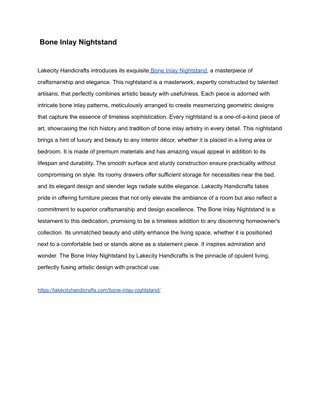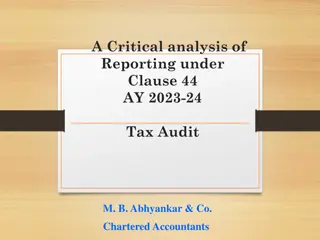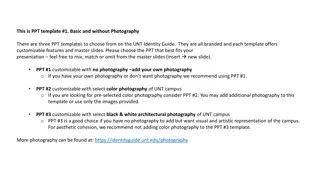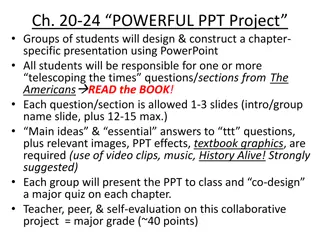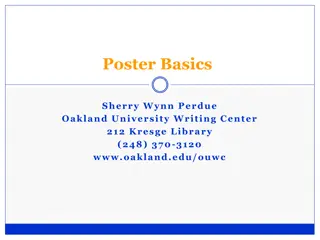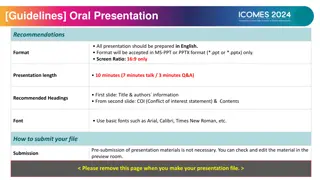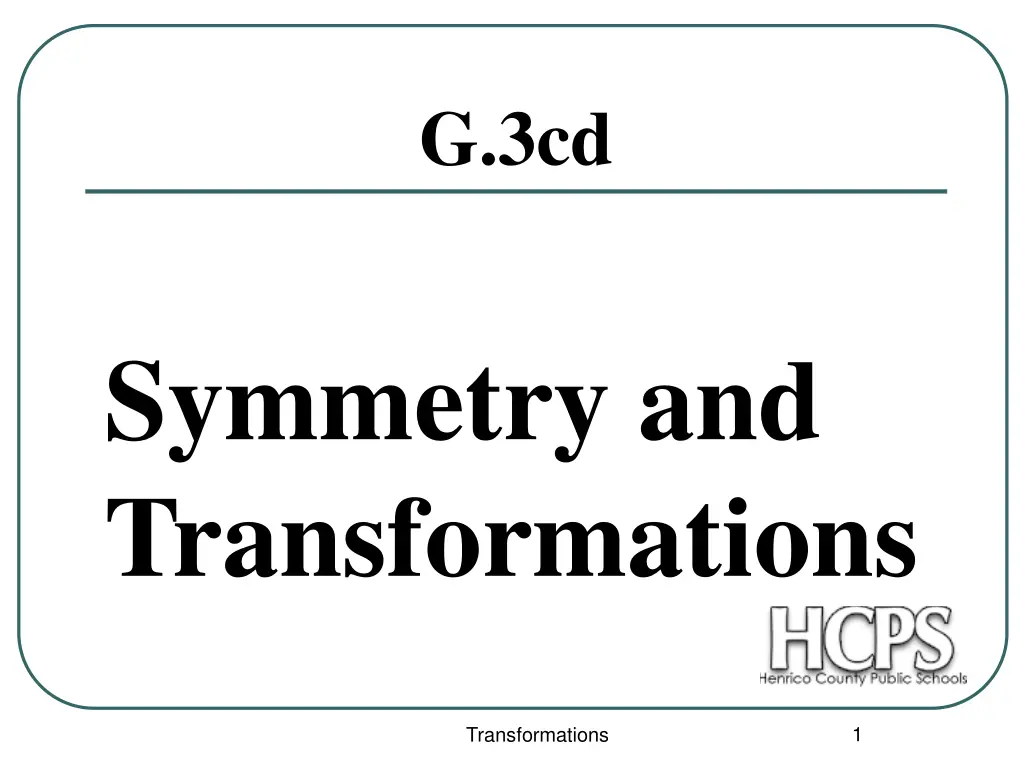
Understanding Symmetry and Transformations in Geometry
Explore the concept of symmetry and transformations in geometry, including lines of symmetry, point of symmetry, and different types of transformations such as reflections, translations, rotations, and dilations. Learn how figures can be reflected across specific lines to create mirror images with preserved measures.
Download Presentation

Please find below an Image/Link to download the presentation.
The content on the website is provided AS IS for your information and personal use only. It may not be sold, licensed, or shared on other websites without obtaining consent from the author. If you encounter any issues during the download, it is possible that the publisher has removed the file from their server.
You are allowed to download the files provided on this website for personal or commercial use, subject to the condition that they are used lawfully. All files are the property of their respective owners.
The content on the website is provided AS IS for your information and personal use only. It may not be sold, licensed, or shared on other websites without obtaining consent from the author.
E N D
Presentation Transcript
G.3cd Symmetry and Transformations 1 Transformations
Lines of Symmetry If a line can be drawn through a figure so the one side of the figure is a reflection of the other side, the line is called a line of symmetry. Some figures have 1 or more lines of symmetry. Some have no lines of symmetry. Four lines of symmetry One line of symmetry Two lines of symmetry Infinite lines of symmetry No lines of symmetry 2 Transformations
Point of Symmetry A figure with point of symmetry can be turned about a center point less than 360 and coincide with the original figure. For example: For each figure, state the angle that the figure can be turned and coincide with the original figure. 3 Transformations
Be careful!! 4 Transformations
Types of Transformations Reflections: These are like mirror images as seen across a line or a point. Translations ( or slides): This moves the figure to a new location with no change to the looks of the figure. Rotations: This turns the figure clockwise or counter-clockwise but doesn t change the figure. Dilations: This reduces or enlarges the figure to a similar figure. 5 Transformations
Reflections You can reflect a figure using a line or a point. All measures (lines and angles) are preserved but in a mirror image. Example: The figure is reflected across line l . l You could fold the picture along line l and the left figure would coincide with the corresponding parts of right figure. 6 Transformations
Reflections continued Reflection across the x-axis: the x values stay the same and the y values change sign. (x , y) (x, -y) Reflection across the y-axis: the y values stay the same and the x values change sign. (x , y) (-x, y) n l Example: In this figure, line l : reflects across the y axis to line n (2, 1) (-2, 1) & (5, 4) (-5, 4) reflects across the x axis to line m. (2, 1) (2, -1) & (5, 4) (5, -4) m 7 Transformations
Reflections across specific lines: To reflect a figure across the line y = a or x = a, mark the corresponding points equidistant from the line. i.e. If a point is 2 units above the line its corresponding image point must be 2 points below the line. Example: Reflect the fig. across the line y = 1. (2, 3) (2, -1). (-3, 6) (-6, 2) (-3, -4) (-6, 0) 8 Transformations
Translations (slides) If a figure is simply moved to another location without change to its shape or direction, it is called a translation (or slide). If a point is moved a units to the rightand b units up, then the translated point will be at (x + a, y + b). If a point is moved a units to the leftand b units down, then the translated point will be at (x - a, y - b). Example: A Image A translates to image B by moving to the right 3 units and down 8 units. A (2, 5) B (2+3, 5-8) B (5, -3) B 9 Transformations
Composite Reflections If an image is reflected over a line and then that image is reflected over a parallel line (called a composite reflection), it results in a translation. Example: C B A Image A reflects to image B, which then reflects to image C. Image C is a translation of image A 10 Transformations
Rotations An image can be rotated about a fixed point. The blades of a fan rotate about a fixed point. An image can be rotated over two intersecting lines by using composite reflections. Image A reflects over line m to B,image B reflects over line n to C. Image C is a rotation of image A. A C m B n 11 Transformations
Rotation is simply turning about a fixed point. For our purposes, the fixed point will be the origin Rotate 90 counterclockwise about the origin origin origin Rotate 180 about the about the Rotate 90 clockwise
CLOCKWISE is like a right turn.
Hands in the air on the wheel. Left hand is x Right hand is y
Make a clockwise turn. Which hand is at 12 o clock first? X
Rotate 90 degrees clockwise. ( , ) x y ( , y x ) Change the sign of x &
Example: Rotate 90 degrees clockwise. ( , ) x y ( , ) 3 1 , ) 2 3 , 3 ( , 1 ( , y ( , ) ( , ) ( , ) ( , ) ) x ( ( 3 ) ) 4
Rotate 90 clockwise ( , ) 7 3 ( , ) ( , ) 1 4 ( , ) ( , ) 3 1 ( , )
Rotate 90 clockwise ( 2 , 2 ) ( , ) ( 2 , 9 ) ( , ) ( , 4 2 ) ( , ) ( , 4 9 ) ( , )
COUNTERCLOCKWISE is like a left turn.
Hands in the air on the wheel. Left hand is x Right hand is y
Make a counterclockwise turn. Which hand is at 12 o clock first? Y
Rotate 90 degrees counterclockwise. ( , ) x y ( , ) y x Change the sign of y & Switch the order of x and y
Example: Rotate 90 degrees counterclockwise. ( , ) x y ( , ) 3 1 , ) 2 3 , 3 ( , 1 ( , ) ( , ) ( , ) ( , ) , ) y x ( ( ( 3 ) ) 4
Rotate 90 counterclockwise ( 3 , 2 ) ( , ) ( , ) 6 5 ( , ) ( , ) 0 2 ( , )
Rotate 90 counterclockwise ( 10 , ) 3 ( , ) ( 2 , ) 4 ( , ) ( , ) 0 1 ( , )
Rotating 180 degrees changes the sign of the x and the sign of the y. (or rotate 90 twice) (for 270 rotate 90 3x)
Rotate 180 degrees. ( , ) x y ( x , y ) Keep the order
Example: Rotate 180 degrees. , ) ) 3 ) 4 ( ( ( ( , ) ( , ) x y ( , ) 3 1 ( 2 3 , 3 ( , 1 ( , ) x y , ) , ) , ) (
Rotate 180 ( 8 , 2 ) ( , ) ( 8 , 9 ) ( , ) ( 2 , 2 ) ( , ) ( 2 , 9 ) ( , )
Rotate 180 ( 2 , 1 ) ( , ) ( 4 , ) 5 ( , ) ( , 2 2 ) ( , )
Angles of rotation In a given rotation, where A is the figure and B is the resulting figure after rotation, and X is the center of the rotation, the measure of the angle of rotation AXB is twice the measure of the angle formed by the intersecting lines of reflection. Example: Given segment AB to be rotated over lines l and m, which intersect to form a 35 angle. Find the rotation image segment KR. B A 35 32 Transformations
Angles of Rotation . . Since the angle formed by the lines is 35 , the angle of rotation is 70 . 1. Draw AXK so that its measure is 70 and AX = XK. 2. Draw BXR to measure 70 and BX = XR. 3. Connect K to R to form the rotation image of segment AB. B K A R 35 X 33 Transformations
Dilations A dilation is a transformation which changes the size of a figure but not its shape. This is called a similarity transformation. Since a dilation changes figures proportionately, it has a scale factor k. If the absolute value of k is greater than 1, the dilation is an enlargement. If the absolute value of k is between 0 and 1, the dilation is a reduction. If the absolute value of k is equal to 0, the dilation is congruence transformation. (No size change occurs.) 34 Transformations
Dilations continued In the figure, the center is C. The distance from C to E is three times the distance from C to A. The distance from C to F is three times the distance from C to B. This shows a transformation of segment AB with center C and a scale factor of 3 to the enlarged segment EF. A E R A B F C C W B In this figure, the distance from C to R is the distance from C to A. The distance from C to W is the distance from C to B. This is a transformation of segment AB with center C and a scale factor of to the reduced segment RW. 35 Transformations
Dilations examples Find the measure of the dilation image of segment AB, 6 units long, with a scale factor of 1. S.F. = -4: the dilation image will be an enlargment since the absolute value of the scale factor is greater than 1. The image will be 24 units long. 2. S.F. = 2/3: since the scale factor is between 0 and 1, the image will be a reduction. The image will be 2/3 times 6 or 4 units long. 3. S.F. = 1: since the scale factor is 1, this will be a congruence transformation. The image will be the same length as the original segment, 1 unit long. 36 Transformations







